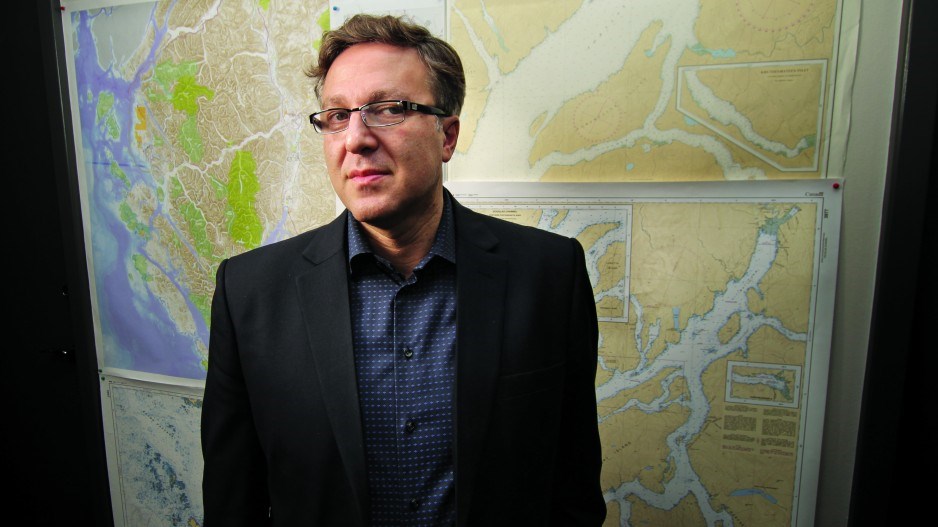When the federal government killed the Northern Gateway pipeline project in November, residents of Kitimat, where it would have terminated, were happy with the decision.
The District of Kitimat even published an open letter to Canadians in newspapers applauding the decision. If any oil moves through Kitimat, it should be through a refinery, the district said.
“Kitimat supports value-added opportunities across the nation that benefit our economy at the same time as reducing environmental risks, including proposed oil refineries and LNG terminals in the Kitimat region,” the district wrote.
That’s the kind of community support B.C. media mogul David Black will need to raise the $10 million he needs just to get his $18 billion Kitimat Clean refinery proposal through the environmental review process.
It is one of two export refineries proposed for the Kitimat region and likely would never have been contemplated were it not for Northern Gateway, because Kitimat Clean was pitched as a better alternative to an oil pipeline.
However, West Coast refineries built to serve Asian markets could face some challenges. While demand for refined petroleum products is growing throughout Asia, so is its refining capacity.
Most of the world’s new refineries in the past decade have been built in Asia and the Middle East. Twenty new oil refineries were planned for Asia between 2014 and 2018 – seven in China and three in India, according to a 2014 Gaffney, Cline & Associates analysis.
Countries like China are prepared to over-invest in refining capacity because they want the energy security refineries provide. Refineries are also a critical part of the petrochemical industries in India and China.
“For Canada to develop its own refining capacity now would be to increase the global overcapacity problem and make a high-cost, upfront investment into a global market that’s probably oversupplied for some time to come,” David Elmes, a professor at the Warwick Business School’s Global Energy Research Network, told Business in Vancouver.
Any North American refinery that would make petroleum products for the Asian market would also be trying to sell into markets that use price controls that keep fuel prices below market value.
“You will likely have to find a buyer willing to provide a long-term agreement for fair market value for your product, and many of these countries have regulated refined product prices or pump prices that may pose a difficult hurdle to striking a favourable deal,” said Kevin Birn, crude oil supply and markets analyst for IHS Markit.
But Jacques Benoit, chief operating officer for Pacific Future Energy, points out that Chinese companies invested heavily in the Canadian oilsands with the expectation of getting access to Alberta oil via new pipelines, one of which will not be built. China National Offshore Oil Corp., for example, acquired Alberta oilsands producer Nexen (NYSE:NXY) in 2013 for $15 billion.
“They probably would prefer to have it as raw bitumen, but they can’t get at it, so they’ll take it as gasoline and diesel,” Benoit said.
“We’re taking the feedstock from Chinese companies here in Alberta who have invested heavily into the oilsands, and who want access to their product. Right now that’s stranded in Alberta. Secondly, it’s going to the U.S., so they’re not happy with that.”
Though he has nothing in writing, Black said he has been given verbal assurance from potential buyers and investors in China that they will buy Kitimat Clean’s petroleum products.
“They left me with no uncertainty as to the fact that they would be delighted to buy it, if it’s cheaper than they can make it, because then they can lock in a source of refined fuel from Canada for 100 years or so,” he said. “They have overcapacity to 2024, but it will take us that long to build ours.”
Despite some of the challenges Kitimat Clean and the $11 billion Pacific Future Energy refinery face, West Coast refineries have some advantages, according to financial services company IHS Markit. Its analysis shows a West Coast refinery would be cheaper to build than a refinery in Alberta because access to tidewater means large modules could be assembled in Asia relatively inexpensively and shipped to B.C.
Neither Kitimat Clean nor Pacific Future Energy would need pipelines. Both propose to bring raw bitumen to Kitimat by rail in the form of “neatbit,” which is bitumen oil in a semi-solid state.
Rail tends to be more expensive than pipelines for moving diluted bitumen (dilbit) or synthetic crude. But those products are created by adding lighter oil products, like condensate, to the bitumen, which adds to its costs.
Shipping neatbit by rail avoids the cost of buying and moving the condensate, as well as some rudimentary refining. IHS Markit analysis confirms that, depending on a variety of factors, neatbit by rail could come close to being competitive with dilbit by pipeline.
“When you get down barrel to barrel, the difference between the two is negligible,” said Samer Salameh, executive chairman of the Pacific Future Energy project.
Both the Kitimat Clean and Pacific Future Energy projects are in the early stages of a Canadian Environmental Assessment Agency review. However, Black has put his project on hold.
He asked for a suspension when the federal environment minister ruled the project would have to be sent to a review panel, which would bring the total cost of going through a review process to about $10 million.
“That was more than I had available for the environmental work, so I needed to go outside to get some investors and, of course, you can’t get investors until you have some basic building blocks in place, like letters of intent with
Pacific Future Energy continues to move ahead. Salameh said his company has already spent $25 million getting the project into the environmental review process, and plans to begin front-end engineering design in the spring.




